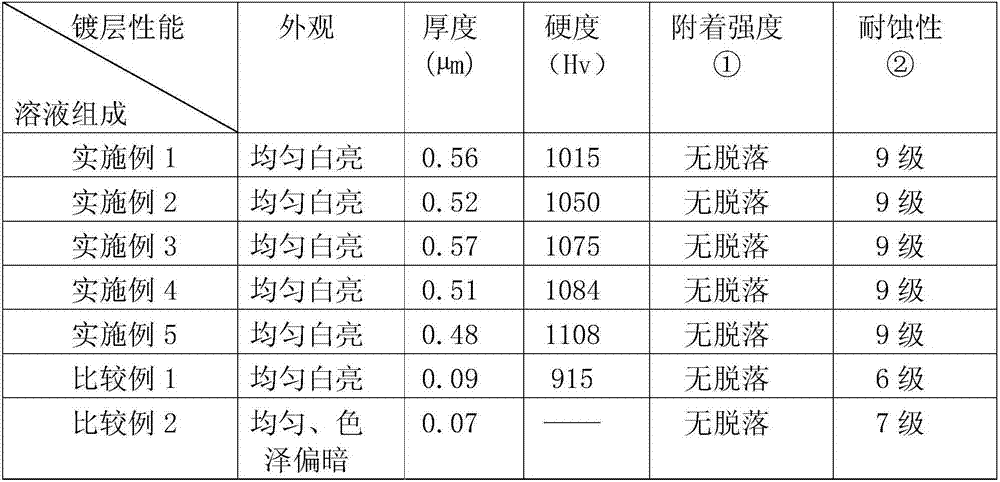A method for converting existing hexavalent chromium plating solution into new trivalent chromium plating solution
A technology of trivalent chromium and hexavalent chromium, which is applied in the field of converting existing hexavalent chromium plating solution into new trivalent chromium plating solution and electroplating chromium, and can solve the problems of slow solution plating speed, poor corrosion resistance and large consumption of chemical materials and other problems, to achieve the effects of decreased kinetic stability, accelerated electrodeposition speed, and environmental protection.
- Summary
- Abstract
- Description
- Claims
- Application Information
AI Technical Summary
Problems solved by technology
Method used
Image
Examples
Embodiment 1
[0016] (1) Existing hexavalent chromium plating solution, its hexavalent chromium content is 250g / L, dilute the plating solution with pure water to hexavalent chromium 140g / L, take 100L plating solution and use 20% sulfuric acid to adjust the pH of the bath value to 0.5, heat to 80-90°C, under stirring, according to the molar ratio of reducing agent and hexavalent chromium is 3:1, slowly and gradually add reducing agent methanol 13.4kg and complexing agent citric acid 57.6kg until the reaction is completed , maintain the temperature at 90°C and keep it warm for 4 hours to form an active ligand [Cr(H 2 C 6 h 6 o 7 )(H 2 O) 5 ], this existing hexavalent chromium plating solution is then converted into a trivalent chromium active ligand basic solution with a trivalent chromium content of 75g / L;
[0017] (2) In the trivalent chromium active ligand basic solution formed by the above-mentioned reaction, add conductive salt ammonium sulfate 5kg, potassium sulfate 5kg and catalys...
Embodiment 2
[0019] (1) Existing hexavalent chromium plating solution, its hexavalent chromium content is 250g / L, dilute the plating solution to 140g / L with purified water, get 100L plating solution and adjust the pH value of bath solution to 0.5 with 20% sulfuric acid, Heat to 80-90°C, under stirring, according to the molar ratio of reducing agent to hexavalent chromium is 3:1, slowly and gradually add reducing agent ethanol 19.7kg instead of methanol, add complexing agent citric acid 57.6kg, until the reaction is completed, Maintaining the temperature at 90°C for 4 hours, the existing hexavalent chromium plating solution is converted into a trivalent chromium active ligand basic solution with a trivalent chromium content of 75g / L;
[0020] (2) In the trivalent chromium active ligand basic solution formed by the above-mentioned reaction, add conductive salt ammonium sulfate 5kg, potassium sulfate 5kg and catalyst, sodium methanedisulfonate 200g, stir until all dissolve, adjust and form tri...
Embodiment 3
[0022] (1) Existing hexavalent chromium plating solution, its hexavalent chromium content is 250g / L, dilute the plating solution to 140g / L with purified water, get 100L plating solution and adjust the pH value of bath solution to 0.5 with 20% sulfuric acid, Heat to 80-90°C, under stirring, according to the molar ratio of reducing agent and hexavalent chromium is 3:1, gradually add reducing agent methanol 13.4kg, use 18.9kg of oxalic acid and 21.8kg of malonic acid to replace the example 1, until the reaction is complete, maintain the temperature at 90°C, and keep it warm for 4 hours to form an active ligand [Cr(C 2 o 4 h 2 )(C 3 o 4 h 2 )(H 2 O) 4 ], this existing hexavalent chromium plating solution is then converted into a trivalent chromium active ligand basic solution with a trivalent chromium content of 75g / L;
[0023](2) In the trivalent chromium active ligand basic solution formed by the above reaction, add conductive salt ammonium sulfate 5kg, potassium sulfate ...
PUM
 Login to View More
Login to View More Abstract
Description
Claims
Application Information
 Login to View More
Login to View More - R&D
- Intellectual Property
- Life Sciences
- Materials
- Tech Scout
- Unparalleled Data Quality
- Higher Quality Content
- 60% Fewer Hallucinations
Browse by: Latest US Patents, China's latest patents, Technical Efficacy Thesaurus, Application Domain, Technology Topic, Popular Technical Reports.
© 2025 PatSnap. All rights reserved.Legal|Privacy policy|Modern Slavery Act Transparency Statement|Sitemap|About US| Contact US: help@patsnap.com

